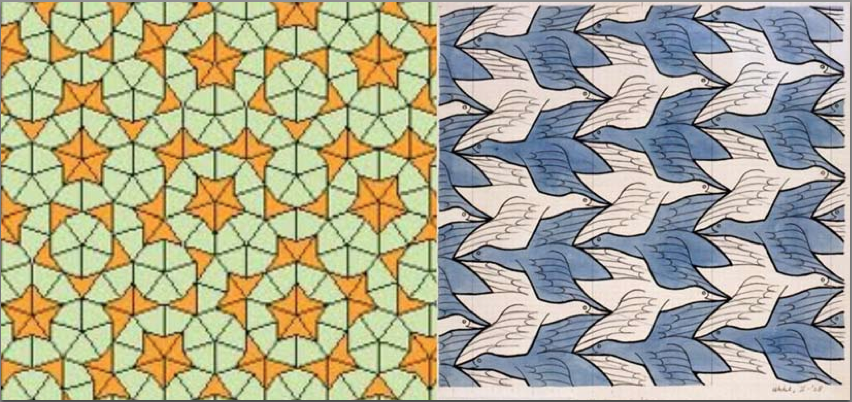Physics 136: Physics & Art
Syllabus · Spring 2015 Prof. Kate Jones-Smith

| Geometric Tiling Pattern | Escher, M.C. Two Birds, 1938 |
Lecture: 1-1:50 pm MWF, G041
Office Hours: 3-5 pm WR, and by appointment; G051 or 1038
Email: kjonessm@hamilton.edu
| Texts: | Taft, W.S. & Mayer, J.W. The Science of Paintings, 2000. Hockney, D. Secret Knowledge: Rediscovering the Lost Techniques of the Old Masters, 2006. Broug, E. Islamic Geometric Patterns, 2008. Mandlebrot, B. The Fractal Geometry of Nature, 1982. Additional readings posted to Blackboard. |
Description:
This class consists of six different episodes in which some juxtaposition of physics and art is present. Some episodes involve the use of physics in order to understand or reveal the context of art, and some link the content of the art to physical or mathematical concepts. The episodes proceed in chronological order beginning with prehistoric cave paintings and ending with abstract art from the 20th century, as listed below.
Assignments & Goals:
Each episode has a distinct connection between an artistic tech- nique, era, or set of objects, and a mathematical or physical concept. Ideally you will be be able to articulate this connection at the end of each episode, so that you could explain it to family or friends who have not taken the course. The lectures, readings, and homework assignments are designed to facilitate this understanding. Each episode will have assigned reading; it is crucial that you complete the assigned reading for each episode. To enforce this, each episode will have a worksheet based on the lectures and reading. Most episodes will involve an additional assignment (e.g. constructing a camera obscura, creating a tiling pattern with a straight edge and compass) to further your appreciation for the physics and/or artistry involved.
Exams & Grading Scheme
There will be about 10-12 assignments and 3 exams over the course of the semester. The exams will come at the end of each unit which contains two episodes. (There will be no final exam.) The exams are each worth 15% of your grade and the homework assignments make up the remaining 55%. Please note the attendance policy below, which is that you cannot get an A in the class if you miss more than two classes without a valid, documented excuse.
Policies:
Laptops, cell phones, tablets, etc. are not allowed in lecture. If you wish to take notes it should be on paper by hand. If this poses any difficulty for you please let me know and we can find a solution that suits your needs. Please bear in mind that my lecture notes and slides will be available on Blackboard after each lecture. Attendance is required. The material in this course is not presented in the same manner and to the same degree of detail anywhere else. Thus you are required to attend class, so that you can get the full story and get the most out of this class. More specifically, you cannot miss more than two classes and get an A in the course. I can accommodate more absences if you can provide a valid, documented excuse (e.g. note from a doctor, athletics, proof of travel to conference, etc.).
Accommodations:
I request that anyone needing academic adjustments or accommo- dations speak with me during the first two weeks of class. All discussions will remain confidential. Students with disabilities should also contact Allen Harrison, Associate Dean of Students for Multicultural Affairs and Accessibility Services in the Office of the Dean of Students (Elihu Root House; ext. 4021) who coordinates services for students with disabil- ities.
Episodes:
The episodes we will cover this semester are divided into three units as follows:
Unit I: Ancient Era
· Cave Paintings and Radiocarbon Dating
· Multispectral Imaging and the Archimedes Palimpsest
Unit II: Medieval Era
· Islamic Geometric Patterns, Penrose Tiles, and Quasicrystals · Renaissance Paintings and the Hockney-Falco Hypothesis
Unit III: Modern Era
· Modern Art and Modern Physics
· Chaos, Fractals, and the Drip Paintings of Jackson Pollock
